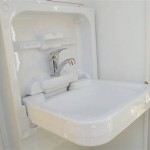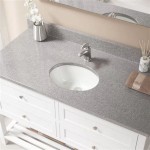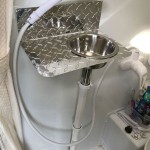Eliminating the Egg Odor: Understanding and Addressing Bathroom Sink Drain Smells
A persistent rotten egg smell emanating from a bathroom sink drain is an unpleasant and often perplexing problem for homeowners. This offensive odor is typically indicative of a specific issue within the drain system, most commonly the presence of hydrogen sulfide gas. Understanding the source of this gas and taking appropriate measures to eliminate it are crucial for maintaining a hygienic and odor-free bathroom environment.
The purpose of this article is to provide a comprehensive overview of the factors contributing to the rotten egg smell emanating from bathroom sink drains. It will delve into the biological and chemical processes involved, identify common causes and contributing factors, and outline a range of effective troubleshooting and remediation strategies. This guide is designed to equip individuals with the knowledge necessary to diagnose the source of the odor and implement solutions that address the root cause, ultimately restoring a fresh and clean atmosphere in the bathroom.
The Science Behind the Stench: Hydrogen Sulfide and its Formation
The primary culprit behind the rotten egg smell is hydrogen sulfide (H₂S), a colorless gas characterized by its distinctive and pungent odor. This gas is a natural byproduct of anaerobic decomposition, a process occurring in the absence of oxygen. In the context of a bathroom sink drain, anaerobic decomposition typically involves the breakdown of organic matter by sulfate-reducing bacteria (SRB).
SRBs are microorganisms that thrive in environments lacking free oxygen. They obtain energy by reducing sulfate ions (SO₄²⁻) to hydrogen sulfide. Sulfate ions are commonly present in water, particularly well water, and can also be introduced through detergents, soaps, shampoos, and other personal care products that are washed down the drain. As organic materials, such as hair, soap scum, toothpaste residue, and dead skin cells, accumulate within the drainpipe, they provide a food source for SRBs. The combination of sulfate ions, organic matter, and an anaerobic environment creates ideal conditions for H₂S production.
The chemical reaction involved can be simplified as follows: SO₄²⁻ + Organic Matter + SRB → H₂S + Other Byproducts. This reaction highlights the crucial role played by both the presence of sulfate-containing compounds and the activity of sulfate-reducing bacteria in generating the offending odor. The concentration of H₂S required to produce a noticeable smell is remarkably low, often detectable at levels as minute as a few parts per billion (ppb). This explains why even a small amount of H₂S production within the drain can result in a strong and unpleasant odor.
Identifying the Culprits: Common Causes and Contributing Factors
Several factors can contribute to the accumulation of organic matter, the proliferation of SRBs, and the subsequent production of hydrogen sulfide in bathroom sink drains. These factors can be broadly categorized as related to water quality, drainage system design, maintenance practices, and user habits.
Water Quality: The type of water supply plays a significant role. Well water, as previously mentioned, often contains higher concentrations of sulfates than municipal water. Additionally, water softeners, while beneficial for reducing mineral buildup, can exacerbate the problem by converting calcium and magnesium sulfates into sodium sulfate, further increasing the sulfate load in the drain system. Testing the water supply for sulfate levels can help determine if this is a contributing factor and guide the selection of appropriate water treatment solutions.
Drainage System Design and Traps: A properly functioning P-trap is essential for preventing sewer gases, including hydrogen sulfide, from entering the bathroom. The P-trap is a U-shaped section of pipe designed to hold water, creating a seal that blocks the passage of gases. If the P-trap is dry due to infrequent use of the sink (e.g., in a guest bathroom), evaporation can break the seal, allowing sewer gases to escape. Similarly, improper installation or damage to the P-trap can compromise its ability to maintain a seal. Occasionally, a venting problem in the plumbing system can siphon water from the P-trap, leading to the same issue.
Maintenance Practices: Infrequent cleaning of the drain can lead to a buildup of organic matter along the drainpipe walls. Hair, soap scum, and other debris accumulate and provide an ideal breeding ground for SRBs. Regular flushing of the drain with hot water and occasional cleaning with appropriate drain cleaners can help prevent this buildup.
User Habits: The types of products used in the sink can also contribute to the problem. Certain soaps, shampoos, and shaving creams contain sulfates and other organic compounds that promote SRB growth. Also, flushing excessive amounts of hair down the drain exacerbates the issue.
Effective Remediation Strategies: Addressing the Root Cause
Addressing the rotten egg smell requires a multi-pronged approach that focuses on eliminating the source of hydrogen sulfide production. This involves cleaning the drain, addressing water quality issues, ensuring proper P-trap function, and implementing preventive maintenance practices.
Cleaning the Drain: The first step is to thoroughly clean the drain to remove accumulated organic matter. This can be accomplished using several methods. A simple approach is to flush the drain with boiling water. The hot water helps to dislodge debris and kill some of the bacteria. However, caution should be exercised when using boiling water, especially with PVC pipes, as excessive heat can damage them. It is advisable to pour the boiling water slowly and in stages to avoid thermal shock. Alternatively, enzymatic drain cleaners specifically designed to break down organic matter can be used. These cleaners contain enzymes that digest hair, soap scum, and other debris without harming the pipes. Chemical drain cleaners should be used with extreme caution, as they can be corrosive and potentially damage plumbing fixtures. Always follow the manufacturer's instructions carefully and wear appropriate protective gear when using chemical drain cleaners.
A manual cleaning approach involves using a drain snake or auger to physically remove debris from the drainpipe. This can be particularly effective for removing large clumps of hair and other stubborn blockages. Care should be taken not to damage the pipes during the snaking process. Disassembling and cleaning the P-trap can also be beneficial. This allows for a thorough cleaning of the trap and removal of any accumulated sediment.
Addressing Water Quality Issues: If high sulfate levels in the water supply are suspected, several options can be considered. Installing a whole-house water filter can help reduce sulfate levels. Reverse osmosis (RO) systems are particularly effective at removing sulfates and other contaminants from water. However, RO systems can be relatively expensive. Another option is to switch to sulfate-free soaps, shampoos, and detergents. This can help reduce the amount of sulfate entering the drain system.
Ensuring Proper P-Trap Function: Regularly check the P-trap to ensure that it contains water. If the sink is not used frequently, periodically pour water down the drain to replenish the P-trap seal. If the P-trap is damaged or improperly installed, it should be repaired or replaced by a qualified plumber. Inspect drain vents to make sure that they are not blocked. Blocked vents can create negative pressure in the drain system, siphoning water from the P-traps.
Implementing Preventive Maintenance Practices: Regular flushing of the drain with hot water can help prevent the accumulation of organic matter. Consider using a drain strainer to catch hair and other debris before they enter the drainpipe. Regularly cleaning the sink and surrounding area can also help reduce the amount of organic matter that enters the drain. Avoiding the disposal of oily or greasy substances down the drain can further minimize the buildup of organic matter.
In some cases, the source of the odor may not be immediately apparent. If the problem persists despite implementing the above strategies, it may be necessary to consult a professional plumber. A plumber can use specialized equipment, such as a video inspection camera, to inspect the drainpipe and identify any hidden blockages or problems that may be contributing to the odor. They can also provide expert advice on the most appropriate solutions for the specific situation. Identifying and addressing the root cause of the rotten egg smell from bathroom sink drains involves understanding the underlying biological and chemical processes, identifying contributing factors, and implementing a combination of cleaning, maintenance, and water treatment strategies.

What To Do When Your Drains Smell Like Rotten Eggs Black Haak

Do Your Drains Smell Like Rotten Eggs Huft Home Services

Why Do My Drains Smell Like Rotten Eggs

Why A Drain Smells Like Rotten Eggs Or Sulfur Mr Rooter Plumbing

Smelly Sink Some Tips On Making Your Drains Smell Fresh Bates Environmental

How To Get Rid Of The Sewer Smell From A Bathroom Terry S Plumbing

How Can I Help A Stinky Bathroom Sink Drain Cleaning More

Your Toilet Smells Like Rotten Eggs Mr Rooter
There Is A Foul Rotten Egg Odor Coming From The Second Floor Bathroom Sinks In My House Whenever I Run Hot Water We Ve Tried Some Home Remedies For It But They

Does Your Water Smell Like Rotten Eggs Treatment Test







